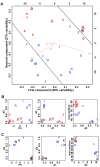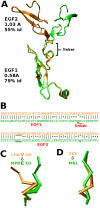Deciphering the shape and deformation of secondary structures through local conformation analysis
- PMID: 21284872
- PMCID: PMC3224362
- DOI: 10.1186/1472-6807-11-9
Deciphering the shape and deformation of secondary structures through local conformation analysis
Abstract
Background: Protein deformation has been extensively analysed through global methods based on RMSD, torsion angles and Principal Components Analysis calculations. Here we use a local approach, able to distinguish among the different backbone conformations within loops, α-helices and β-strands, to address the question of secondary structures' shape variation within proteins and deformation at interface upon complexation.
Results: Using a structural alphabet, we translated the 3 D structures of large sets of protein-protein complexes into sequences of structural letters. The shape of the secondary structures can be assessed by the structural letters that modeled them in the structural sequences. The distribution analysis of the structural letters in the three protein compartments (surface, core and interface) reveals that secondary structures tend to adopt preferential conformations that differ among the compartments. The local description of secondary structures highlights that curved conformations are preferred on the surface while straight ones are preferred in the core. Interfaces display a mixture of local conformations either preferred in core or surface. The analysis of the structural letters transition occurring between protein-bound and unbound conformations shows that the deformation of secondary structure is tightly linked to the compartment preference of the local conformations.
Conclusion: The conformation of secondary structures can be further analysed and detailed thanks to a structural alphabet which allows a better description of protein surface, core and interface in terms of secondary structures' shape and deformation. Induced-fit modification tendencies described here should be valuable information to identify and characterize regions under strong structural constraints for functional reasons.
Figures







Similar articles
-
Structural deformation upon protein-protein interaction: a structural alphabet approach.BMC Struct Biol. 2008 Feb 28;8:12. doi: 10.1186/1472-6807-8-12. BMC Struct Biol. 2008. PMID: 18307769 Free PMC article.
-
Mining protein loops using a structural alphabet and statistical exceptionality.BMC Bioinformatics. 2010 Feb 4;11:75. doi: 10.1186/1471-2105-11-75. BMC Bioinformatics. 2010. PMID: 20132552 Free PMC article.
-
Local structural differences in homologous proteins: specificities in different SCOP classes.PLoS One. 2012;7(6):e38805. doi: 10.1371/journal.pone.0038805. Epub 2012 Jun 22. PLoS One. 2012. PMID: 22745680 Free PMC article.
-
[A turning point in the knowledge of the structure-function-activity relations of elastin].J Soc Biol. 2001;195(2):181-93. J Soc Biol. 2001. PMID: 11727705 Review. French.
-
Hidden Markov model-derived structural alphabet for proteins: the learning of protein local shapes captures sequence specificity.Biochim Biophys Acta. 2005 Aug 5;1724(3):394-403. doi: 10.1016/j.bbagen.2005.05.019. Biochim Biophys Acta. 2005. PMID: 16040198 Review.
Cited by
-
Exploring the potential of a structural alphabet-based tool for mining multiple target conformations and target flexibility insight.PLoS One. 2017 Aug 17;12(8):e0182972. doi: 10.1371/journal.pone.0182972. eCollection 2017. PLoS One. 2017. PMID: 28817602 Free PMC article.
-
Local conformational changes in the DNA interfaces of proteins.PLoS One. 2013;8(2):e56080. doi: 10.1371/journal.pone.0056080. Epub 2013 Feb 13. PLoS One. 2013. PMID: 23418514 Free PMC article.
-
SAFlex: A structural alphabet extension to integrate protein structural flexibility and missing data information.PLoS One. 2018 Jul 5;13(7):e0198854. doi: 10.1371/journal.pone.0198854. eCollection 2018. PLoS One. 2018. PMID: 29975698 Free PMC article.
-
SA-Mot: a web server for the identification of motifs of interest extracted from protein loops.Nucleic Acids Res. 2011 Jul;39(Web Server issue):W203-9. doi: 10.1093/nar/gkr410. Epub 2011 Jun 10. Nucleic Acids Res. 2011. PMID: 21665924 Free PMC article.
References
MeSH terms
LinkOut - more resources
Full Text Sources

